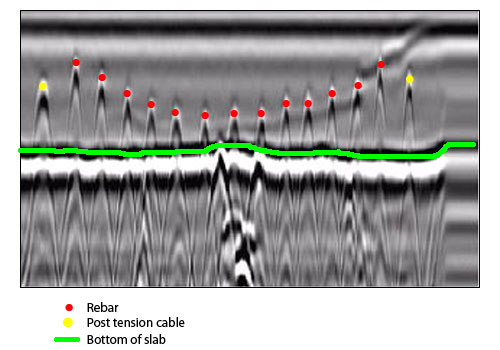Past the Surface Area: Leveraging Advanced Concrete Scanning Techniques for Unmatched Accuracy and Understanding
Advanced concrete scanning methods have arised as crucial tools in this search, using a peek beneath the surface to unveil a globe of essential understandings. By taking advantage of cutting-edge modern technologies, experts can reveal anomalies, analyze the condition of concrete structures, and make notified choices that form the program of tasks.
Significance of Advanced Concrete Scanning
The significance of using innovative concrete scanning methods hinges on the exceptional accuracy they provide for finding sub-surface anomalies and ensuring structural honesty. By employing advanced modern technologies such as ground-penetrating radar (GPR), electro-magnetic induction, and progressed finder imaging, construction professionals can delve beneath the surface of concrete structures with a level of accuracy that far surpasses conventional evaluation techniques. Concrete Scanning. These strategies allow the recognition of concealed dangers like rebar rust, spaces, channels, or post-tension cable televisions that could compromise the stability and safety of a structure over time
Moreover, progressed concrete scanning provides important insights into the total problem of a concrete component without the demand for invasive steps, reducing the danger of triggering damage throughout the evaluation process. The capability to pinpoint the exact location and deepness of prospective issues permits targeted repairs and upkeep, inevitably extending the life expectancy of the structure and maximizing its efficiency. Basically, the significance of advanced concrete scanning can not be overemphasized in the world of building and construction and framework maintenance, where accuracy and dependability are vital.
Kinds of Cutting-Edge Technologies

Anomalies and Issue Discovery

Along with GPR, concrete scanning methods like thermography and impact-echo testing are additionally efficient in detecting anomalies and defects. Thermography uses infrared modern technology to determine variations in surface temperature, indicating prospective locations of worry such as delamination or wetness access. On the other hand, impact-echo testing includes evaluating acoustic actions to find spaces, fractures, and other problems within the concrete. By leveraging these sophisticated techniques, professionals can proactively address architectural concerns, ensuring the longevity and safety and security of concrete frameworks.
Assessing Concrete Problem
Just how can designers accurately review the problem of concrete structures to guarantee their durability and security? Evaluating the concrete condition is an essential aspect of maintaining framework stability. Different advanced concrete scanning look these up strategies are utilized for this objective. Ground-penetrating radar (GPR) is frequently utilized to assess the inner framework of concrete, finding spaces, cracks, and various other anomalies that may compromise its toughness. Furthermore, impact-echo testing can give insights right into the density and integrity of concrete aspects. Ultrasonic pulse velocity screening is another beneficial method for reviewing concrete high quality by gauging the rate of acoustic waves through the product.
Integrating non-destructive testing techniques with visual evaluations enables for an extensive assessment of concrete condition, enabling engineers to recognize possible concerns early on and carry out timely maintenance or repairs. By leveraging these innovative strategies, designers can make sure the long-lasting resilience and safety of concrete frameworks.
Enhancing Decision-Making Procedures
In the realm of infrastructure monitoring, maximizing decision-making processes is vital for guaranteeing the effective upkeep and longevity of concrete frameworks. Improved decision-making processes in concrete monitoring include utilizing innovative scanning techniques to collect comprehensive data on the problem of structures. By leveraging modern technologies such as ground-penetrating radar and 3D imaging, stakeholders can make educated choices relating to reinforcement, substitute, or repair techniques.
These progressed scanning techniques offer invaluable insights right into the internal structure of concrete, recognizing prospective concerns such as voids, fractures, or corrosion that may not be noticeable on the surface. This degree of comprehensive details permits aggressive maintenance planning, lessening the threat of structural failings and increasing the general life-span of concrete frameworks.
Furthermore, by integrating electronic paperwork and evaluation tools into the decision-making process, stakeholders can track the evolution of concrete conditions gradually, making it possible for anticipating upkeep approaches and optimizing resource allowance. Eventually, the combination of sophisticated concrete scanning methods improves decision-making processes by offering unrivaled accuracy, insight, and efficiency in infrastructure monitoring.
Verdict
To conclude, progressed concrete scanning methods provide unequaled precision and insight in spotting anomalies, defects, and analyzing the problem of concrete structures. By leveraging advanced technologies, decision-making procedures can be improved, resulting in more effective and informed remedies for keeping and repairing concrete infrastructure. These strategies play see page a vital role in ensuring the safety and security and durability of concrete structures, making them an indispensable device in the field of building and construction and engineering.
Moreover, progressed concrete scanning offers invaluable understandings see it here into the general condition of a concrete component without the need for intrusive steps, minimizing the threat of triggering damages during the analysis process - Concrete Scanning. An additional innovative modern technology is 3D X-ray scanning, which offers thorough pictures of the inner structure of concrete, offering beneficial info without the need for harmful testing. Furthermore, Concrete Cover Meters are utilized to measure the thickness of concrete cover over support bars accurately. Improved decision-making procedures in concrete monitoring include making use of advanced scanning methods to collect detailed data on the problem of frameworks.In conclusion, advanced concrete scanning strategies offer exceptional precision and understanding in spotting abnormalities, issues, and assessing the condition of concrete structures